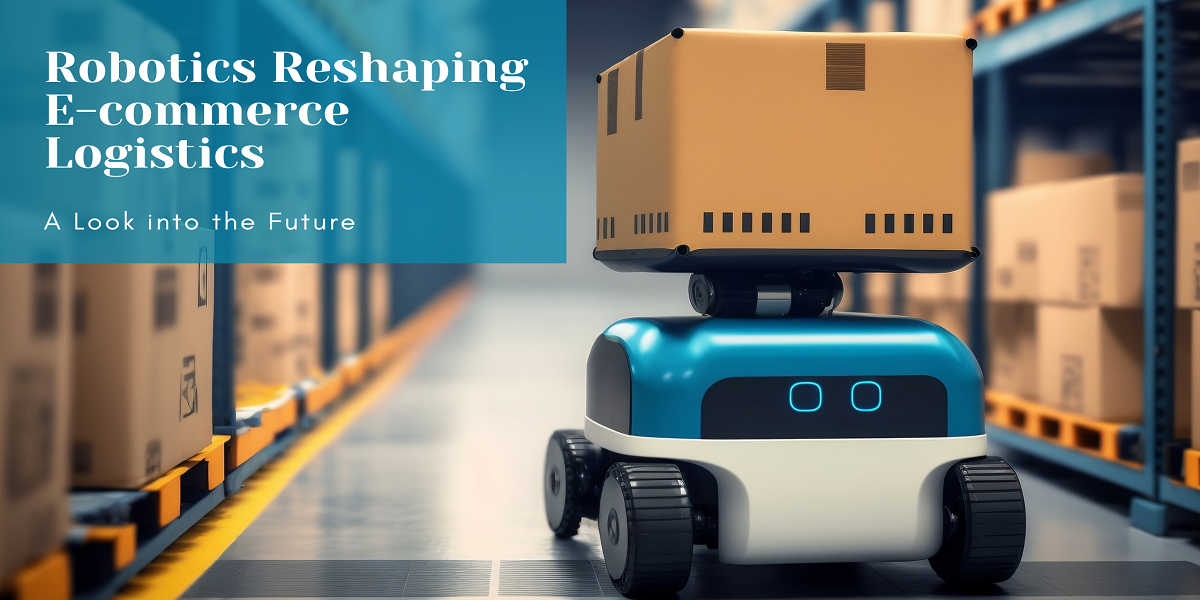
Robotics Reshaping E-commerce Logistics: A Look into the Future
- By Prakriti Agarwal
- 27-02-2024
- Artificial Intelligence
Consumers today expect speedy, dependable deliveries, and the business is intensely competitive, with e-commerce growing at a double rate. With competition comes the option for customers to pick from.
This situation calls for precise, timely, and error-free last-mile deliveries to satisfy & retain customers.
As the e-commerce market changes, the integration of automation and robots emerges as a transformative answer to the issues of last-mile logistics. Automation and robotics are at the front lines of this transformative shift, aggressively creating solutions that reconsider last-mile logistics and boost efficiency.
This particular robot technology in the logistics & supply chain industry not only promises to improve operational efficiency but also transform how goods are sorted, packed, and dispatched.
This guide will explore how this technology can transform e-commerce logistics, affecting both businesses and consumers in the end.
Evolution of Robotics in E-commerce Logistics
Nowadays, retailers are increasingly switching to automation for picking and packing processes. With the rise of autonomous mobile robots (AMRs), we can envision a future with relatively few human workers working in any fulfilment centres or warehouses.
This transition from manual operations to automation in e-commerce logistics represents the industry's response to increasing demand. Initially relying on manual labour for sorting, packing, and shipping, the sector began with basic mechanisation before progressing to more complex automation solutions. This advancement represented the start of integrating technology to improve efficiency and eliminate human error.
Important Technological Developments Driving Robotic Integration
Advancements in automation software, machine learning, artificial intelligence, and sensor technology have made it possible for robots to carry out some of the hardworking jobs more accurately and efficiently. Robotic systems in logistics are now more capable because of the Internet of Things (IoT), which has made real-time data collecting and analysis easier.
These standards have been set by early e-commerce adopters like Amazon. Automated robots for picking and sorting goods transformed Amazon's warehouse operations after the company acquired Kiva Systems, which is now known as Amazon Robotics. Other businesses have also adopted robotic solutions into their diverse logistical processes, demonstrating observable improvements in cost- and operational effectiveness.
Current Applications of Robotics in E-commerce Logistics
Warehouse Automation
The handling of goods & commodities in warehouses has been transformed by robotics technology. Sorting goods, packing them for shipping, and inventory management – everything is done by automated robots. These robots have excellent precision and speed while navigating through huge warehouses, identifying merchandise, and preparing orders. Order fulfilment can happen more quickly because of automation's substantial productivity boost and reduction of human mistakes.
Drones and Autonomous Vehicles
Drones and driverless cars are being intelligently used in the last mile, or the last leg of the delivery process where a package arrives at the customer's doorstep. Drones are being tested & experimented with for aerial delivery, which offers faster and more affordable delivery possibilities, especially in remote places. Advanced navigation systems-equipped autonomous delivery vehicles are being used in cities to transport packages without the assistance of a human driver.
Combining AI with Machine Learning
Robotics in logistics has advanced to the point where machine learning (ML) and artificial intelligence (AI) are essential. Robots can now learn from their experiences, adjust to new surroundings, and make deft decisions thanks to these technologies. Robots powered by AI, for example, can plan and schedule the most efficient routes for sorting and moving goods within a warehouse or maximising delivery routes instantly. This greatly increases overall efficiency and improves operational precision.
Benefits of Robotics in E-commerce Logistics
Improved efficiency and productivity
Robotics streamlines e-commerce logistics operations by automating repetitive and time-consuming processes. This leads to faster processing times, allowing more requests to be handled with greater speed. Robots can perform continuously without taking breaks, considerably increasing overall productivity levels.
Cost Reduction and Return on Investment
While the initial investment in robotics can be expensive, these technologies result in significant long-term cost reductions. Automated systems reduce the need for manual labour, which lowers labour expenses. Furthermore, robots' efficiency and speed result in a faster return on investment (ROI) due to improved throughput and lower operational costs.
Improved accuracy and customer satisfaction.
Robotics technology is very exact, which means fewer errors in order fulfilment. This accuracy guarantees that clients receive the correct products in a timely way, hence increasing customer satisfaction. The dependability and consistency of robotic systems contribute to a better customer experience by ensuring order accuracy and prompt delivery.
Environmental Benefits: Reduced Carbon Footprint
Robotics in e-commerce logistics can help to ensure environmental sustainability. Automated systems optimise routes and streamline operations, resulting in lower energy use. Furthermore, the efficiency of robotic systems can result in fewer transportation trips and optimised packaging, both of which help to reduce carbon footprint. This is consistent with the growing trend of eco-consciousness in company operations.
Challenges and Considerations
High initial investment and maintenance costs.
Integrating robotics into e-commerce logistics frequently needs a significant upfront investment. This includes not just the cost of procuring the robots, but also the costs associated with establishing the required infrastructure. Furthermore, maintenance expenses might be high, as these modern devices require frequent maintenance, repairs, and software updates to function properly.
Technical and Infrastructure Limitations
The current technological and infrastructural environment is critical for the successful application of robotics in logistics. The challenges include establishing compatibility between robotic systems and current IT infrastructure, the necessity for reliable power supplies, and the availability of physical areas to accommodate robotic equipment. Furthermore, in locations with less developed technological infrastructures, implementing advanced robotics can be more difficult.
Workforce Impact and the Need for Re-Skilling
The introduction of robotics into logistics can have a substantial impact on the workforce. While automation may lessen the need for manual labour, it also increases the demand for qualified workers who can manage, operate, and collaborate with these robotic systems. This transition involves an emphasis on re-skilling and educating people so that they have the technical skills they need to thrive in this new climate.
Regulatory and Ethical Consideration
The application of robotics in logistics creates several regulatory and ethical concerns. Concerns include data privacy, cybersecurity, and assuring compliance with existing labour regulations. Additionally, there are ethical concerns concerning worker displacement and employers' responsibilities to promote fair labour practices in an increasingly automated industry.
Success Stories in Robotics Adoption
Major e-commerce companies have effectively integrated robotics into their logistical systems. These organisations have demonstrated increased efficiency and accuracy in order fulfilment, inventory management, and delivery operations. Examples include the implementation of automated warehouse systems and drone delivery services.
Alibaba's logistics unit, Cainiao Network, has also adopted robotics for e-commerce operations. To increase efficiency, they have implemented robotic sorting systems, automated guided vehicles (AGVs), and drones. These technologies accelerate order fulfilment, cut labour costs, and provide clients with speedier delivery alternatives, demonstrating the global trend of robotics usage in e-commerce logistics.
DHL, a worldwide logistics giant, has introduced robotics into its operations to improve productivity. They use autonomous picking robots for warehouse item retrieval, robotic package sorting systems to automate distribution and test drones and autonomous vehicles for last-mile delivery. These technologies increase order fulfilment, accuracy, and logistics network optimisation, all of which contribute to DHL's commitment to providing efficient and dependable global logistics services.
The Future of Robotics in E-commerce Logistics
Emerging Trends and Technologies in the Horizon
- Development of more advanced autonomous robots capable of performing complicated tasks.
- AI and machine learning are being used to enable smarter, more predictive logistics.
- Drone technology is being used more extensively to transport packages faster and more efficiently.
- Advancements in collaborative robots (cobots) that operate with human staff.
- Implementation of robotics-as-a-service (RaaS) models to provide cost-effective solutions.
Experts’ Predictions for the Next Decade
- Major e-commerce companies are making a substantial shift to completely automated warehousing.
- The widespread use of robot-assisted last-mile delivery services.
- AI-powered robotics enables greater customisation and personalisation in logistics operations.
- The emergence of new job roles centred on robot maintenance and data processing.
- Increased emphasis on sustainability, with robots enabling more environmentally friendly logistics practices.
Potential Effect on Global E-Commerce Dynamics
- Significant boost in efficiency and reduction in delivery times.
- Cost savings in logistics lead to more competitive pricing in the e-commerce sector.
- More efficient supply chains have increased e-commerce enterprises' global reach.
- Changes in the work landscape, with a greater demand for tech-savvy logistics specialists.
- Possible regulatory problems as governments adapt to the new technological era.
Preparing for the Robotic Future in E-commerce
Strategies for Businesses Integrating Robotics
- Assessment and Planning: Businesses should first evaluate their present operations to determine where robotics may offer value. This entails comprehending the unique requirements and restrictions of their logistics operations.
- Pilot programmes: Implementing pilot programmes with robotic technologies enables firms to test and learn without completely redesigning existing systems. It's a low-risk technique to assess effectiveness and address any flaws.
- Scalability Considerations: It is critical to select robotics systems that can expand with corporate expansion. Businesses should prepare for future expansion and ensure that the technology they use can adapt and grow to meet their demands.
Upskilling and Workforce Transformation
- Training Programmes: As robotics grows more prevalent in logistics, the workforce must be taught to operate with these new technologies. Training programmes in robot operation and maintenance are vital.
- Redefining Roles: The introduction of robotics will change the nature of certain employment. Companies should prioritise redefining roles and developing new occupations that complement the robotic workforce, such as system supervisors or data analysts.
- Emphasising Human Skills: Emphasise talents that robots cannot copy, such as critical thinking, creativity, and customer service, to ensure that the human workforce remains an essential component of the logistics process.
Collaboration Opportunities for Tech and E-commerce Companies
- Partnerships with robotics manufacturers: E-commerce enterprises can collaborate with robotics manufacturers to develop customised solutions. These collaborations can result in technologies that are specifically designed to address their logistical issues.
- Open Innovation Platforms: Participating in open innovation platforms where IT companies, startups, and e-commerce businesses work together can result in the creation of cutting-edge logistics solutions.
- Data Sharing and Integration: Effective collaboration entails sharing and integrating data across platforms, resulting in smooth interaction between e-commerce platforms and robotic systems.
Ethical and Societal Impacts of Robotics in E-commerce
Ethical Implications of Automated Systems in the Workforce
- Job Displacement Issues: The use of robotics in e-commerce frequently raises concerns about job displacement, as automation could replace human workers. Ethical considerations include weighing efficiency advantages against potential job losses, as well as determining how to support affected people.
- Fair treatment and safety: It is critical to ensure the fair treatment and safety of workers who engage with or are replaced by these systems. This includes ensuring safe working conditions and thinking about the consequences of human-robot interactions.
Social responsibility and corporations' role in technology deployment
- Corporate Accountability Corporations are responsible for deploying robotic technologies in an ethical manner. This includes thinking about the broader societal implications, such as the environmental impact of robots manufacturing and disposal.
- Community Engagement: Corporations should work with communities and stakeholders to better understand and mitigate any negative consequences. This includes open communication regarding the objectives and consequences of their technology implementation.
Robotics' Impact on Consumer Behaviour and Expectations.
- Elevated Expectations: As robotics become more efficient, consumers' expectations for speed, accuracy, and availability rise. Companies must manage these expectations while maintaining high-quality and ethical business practices.
- Trust and Privacy: The employment of robotics, particularly for delivery and data handling, poses privacy and security concerns. Companies must create and maintain consumer trust in how robotics are utilised and data is secured.
Conclusion
To summarise, the use of robotics in e-commerce logistics is more than just a trend; it represents a fundamental transformation in how firms function. As previously discussed, the future holds enormous promise for advances in robotic technologies, changing global e-commerce dynamics and employment plans.
Staying ahead of the robotic revolution is critical for organisations, particularly logistics company in Kolkata and throughout the world. This entails not only accepting new technologies but also cultivating an environment of creativity and adaptation. The trip ahead is thrilling, and it's time for businesses to prepare for the robotic future.
Recent blog

Harnessing Social Media: Tactics For Powerful Marketing Success Achievement
Social Media | 25-07-2024
7 Hidden Secrets of MSI Laptop Boot Menu Key
Technology | 24-07-2024




